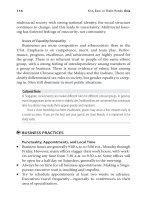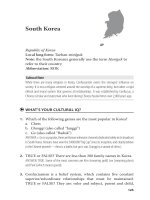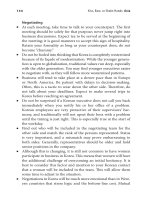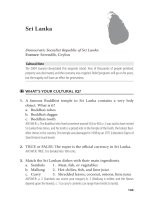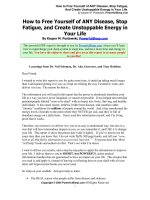53 interesting things to do in your lectures
Bạn đang xem bản rút gọn của tài liệu. Xem và tải ngay bản đầy đủ của tài liệu tại đây (3.24 MB, 154 trang )
Free ebooks ==> www.Ebook777.com
53 interesting things
to do in your
lectures
www.Ebook777.com
Free ebooks ==> www.Ebook777.com
Disclaimer
The publisher and the author make no warranties or representations with respect to the completeness or accuracy of the contents
of this work and specifically disclaim all warranties, including
without limitation warranties of fitness for a particular purpose.
No warranty may be created or extended by sales or promotional
materials.
The advice and strategies contained herein may not be suitable
for every situation. This work is sold with the understanding that
the publisher is not engaged in rendering legal, accounting, or
other professional services. If professional assistance is required,
the services of a competent professional person should be sought.
www.Ebook777.com
53
interesting things
to do in your
lectures
Revised and updated by Anthony Haynes and Karen Haynes
ISBN:
978-1-907076-22-0 (ePub edition)
978-1-907076-23-7 (PDF edition)
978-1-907076-24-4 (Kindle edition)
978-1-907076-30-5 (paperback edition)
Published under The Professional and Higher Partnership imprint
by The Professional and Higher Partnership
Registered office: Mill House, 21 High Street, Wicken, Ely, Cambs,
CB7 5XR, UK
Company website: www.professionalandhigher.com
This edition published 2012.
Based on an earlier edition by Sue Habeshaw, Graham Gibbs, and
Trevor Habeshaw, published by Technical and Educational Services
Ltd (first published 1984). Revised and updated for this edition by
Anthony Haynes and Karen Haynes.
© The Professional and Higher Partnership Ltd
This publication is in copyright. Subject to statutory exception and
to the provisions of relevant licensing agreements, no reproduction
of any part may take place without the written permission of The
Professional and Higher Partnership Ltd.
Credits
Text development and abstract: Anthony Haynes
Copy-editing: Karen Haynes
Cover design: Benn Linfield (bennlinfield.com)
Cover image: Rika Newcombe (www.rikanewcombe.co.uk)
Text design and typesetting: The Running Head Limited
(www.therunninghead.com)
E-book conversion: ePub Direct (www.ePubDirect.com)
Printer: Printondemand-worldwide
(www.printondemand-worldwide.com)
Free ebooks ==> www.Ebook777.com
Contents
Abstract
Professional and Higher Education: series information
Publishers’ foreword
Preface to the first edition
Glossary
ix
x
xi
xiii
xv
Chapter 1 Structuring the process
1 Briefing
2 Flagging
3 Ground rules
4 Students’ questions
5 Orientation
1
3
7
9
11
13
Chapter 2 Improving students’ notes
6 Swop
7 Memory
8 Virtual lectures
9 ‘Now write this down’
10 Displaying your notes
11 Review
12 Looking at students’ notes
15
17
19
23
25
27
29
33
Chapter 3 Using handouts
13 Theme summary
14 Model your discipline
15 Problems
16 Questions
17 Uncompleted handouts
18 Article
19 Reading guide
35
37
39
41
43
45
47
49
www.Ebook777.com
Chapter 4 Structuring and summarising content
20 Structuring
21 Objectives
22 Advance organiser
23 Displaying the structure
24 Progressive structuring
25 Repetition
26 Simultaneous messages
27 The three most important things . . .
51
53
55
57
59
61
63
65
67
Chapter 5 Linking lectures
28 Last week, next week
29 Preparation activities, follow-up activities
30 Spot the links
31 Theme lectures
32 References
69
71
73
77
79
81
Chapter 6 Holding attention
33 Mini-lecture
34 Breaks
35 ‘Now look at me when I’m talking’
36 Ottoman railways
83
85
89
91
93
Chapter 7 Active learning during lectures
37 Lecture tutorials
38 Buzz groups
39 Problem centred and syndicate groups
40 Pyramids
41 Tiers
42 Reading
43 Quiet time
44 Drama
45 Students as teachers
46 Using the audience
47 Debate
95
97
101
103
105
109
111
113
115
117
119
121
vi
Chapter 8 Checking on learning
48 The instant questionnaire
49 The three most important things . . . for students
50 Start with a test
51 Finish with a test
52 Spot test
53 ‘Are there any questions?’
vii
123
125
129
131
133
135
137
viii
Abstract
53 practical ideas for developing lectures are presented. They cover:
structuring the lecturing process; improving students’ notes; using
handouts; structuring and summarising content; linking lectures
to each other; holding the students’ attention; active learning
during lectures; and monitoring learning. For each of the ideas, a
problem or issue is identified and a practical teaching or learning
method is proposed. Overall, the ideas are designed to help reflective practitioners in professional and higher education broaden
their repertoire of pedagogical techniques.
Key terms: higher education; learning; lectures; pedagogy; postcompulsory education; professional education; study; teaching.
ix
Free ebooks ==> www.Ebook777.com
Professional and Higher
Education: series information
Titles in the Professional and Higher Education series include:
53 interesting things to do in your lectures
53 interesting things to do in your seminars and tutorials
53 interesting ways of helping your students to study
x
www.Ebook777.com
Publishers’ foreword
The original edition of 53 interesting things to do in your lectures
was published in a series called ‘Interesting ways to teach’. It
was written by Sue Habeshaw, Graham Gibbs and Trevor Habeshaw – all of them experienced teachers – and published by their
company, Technical and Educational Services. The book proved
popular amongst peers in post-compulsory education and ran to
several editions.
Now that the original authors have retired from teaching, we are
very pleased to have acquired from them the rights to this and
other titles from that series. Much of the original material remains
fresh and helpful. We have, however, revised and updated the text
where appropriate. In four places (items 10, 14, 30 and 36), the
original text has been replaced wholesale.
Anthony Haynes & Karen Haynes
The Professional and Higher Partnership Ltd
xi
xii
Preface to the first edition
This book contains 53 suggestions for things to try out to make
your lectures more interesting and effective. While there are
sound theoretical justifications for these suggestions (and occasionally even empirical evidence in their support) they are offered
here simply as ideas worth trying for yourself.
The suggestions are grouped under broader headings for convenience and are cross-referenced where this is helpful. Every suggestion in this book has been tried out, and seen to work, by the
authors. Each one carries its own number, and a brief description
of the problem or issue it addressses and a description of the
method.
The book is not meant to be read from start to finish, but rather to
be dipped into as each suggestion should make sense on its own.
Where appropriate we have made reference to original sources of
ideas or to places where fuller explanations can be found.
While the book has been written primarily with teachers in further and higher education in mind, the ideas it contains can easily
be modified and adapted for use by teachers in secondary schools,
schools or nursing, and management training, by instructors on
government training projects and others.
Graham Gibbs
Sue Habeshaw
Trevor Habeshaw
xiii
xiv
Glossary
Conventional lecture
50–55 minutes of largely uninterrupted discourse from a teacher
with no discussion between students and no student activity
other than listening and note-taking.
Seminar
A session during which prepared papers are presented to the class
by one or more students.
Tutorial
A discussion session, usually dealing with unspecific content, or a
recent lecture or practical. Chaired by the teacher, it may have any
number of students from one to 20, or so.
Class
Any session during which students are gathered together in the
presence of the teacher.
xv
xvi
Chapter 1
Structuring the process
1
1 Briefing
3
2 Flagging
7
3 Ground rules
9
4 Students’ questions
11
5 Orientation
13
2
1
Briefing
Lectures are used by teachers for an extraordinary variety of purposes. Their relationship to other course elements such as reading, tutorials, assignments and practicals differs markedly from
one course to another. What it is sensible for students to do
during such different lectures also varies enormously. However,
students may respond as if a lecture is a lecture is a lecture, and
behave identically in entirely different situations which demand
quite different learning activities. To brief students at the start of
a lecture is to tell them what sort of a lecture it is to be, and what
sort of learning activity it might be sensible to undertake. Briefing students not only influences their behaviour so that they
make more appropriate and effective use of your lecture in their
learning, but also has an impact on their perceptiveness and discrimination as learners. They will begin to recognise that different learning tasks make different demands and start extending
their repertoire of learning responses accordingly.
We offer a variety of different briefings here to illustrate what we
mean:
a
‘The reason I am lecturing in the way I am is that I want
you to see some live examples of the applications of legal
principles to specific cases. I’m expecting you to learn the
principles from your text books, and to learn to apply legal
principles by tackling the legal problems I’ve prepared for
you which we will discuss in tutorials. In this lecture what I
want you to pay attention to is the way I go about tackling
such problems. I want you to be able to do it like me. There is
only any point in noting down the details of the cases if this
helps you to understand and remember the legal arguments
involved. OK?’
3
Briefing
1
Free ebooks ==> www.Ebook777.com
1
b
‘Your text book deals with these calculations of forces in rigid
structures perfectly adequately, but you may find it difficult
to follow on your own. I’m going to use each of these lectures
to go over one chapter: to explain the methods and notations
the text book uses, and to highlight particular problems or
interesting bits. You could probably manage without these
lectures. You certainly can’t manage without going through
your text book very thoroughly. I’m lecturing to make your
work through your text book that much quicker and easier.
You should make notes in your textbook as I go along, rather
than take full notes.’
c
‘You are only going to get a grip on the social psychology of
groups by reading, and reading quite widely. I’ve given you
a substantial reading list; read as much as you can but you
will find the reading hard going. The authors I’ve chosen all
use different language and make different assumptions even
when considering the same phenomenon. The theoretical
perspectives from which writers approach topics are very
varied and greatly colour the way they write. So the purpose
of my lectures is to try to stop you from getting lost when
you start reading. I’ll familiarise you with the terminology
and highlight some landmarks along the way. I want you to
consider my lectures as maps to a strange land. Take the sort
of notes you’ll find helpful to have next to you when you’re
reading.’
d
‘This lecture introduces you to dialectical materialism. It’s a
difficult concept and one that underpins much of what the
remainder of the course is concerned with. Now I could just
give you a neat definition to write down or some quotes from
Engels for you to copy. But that wouldn’t help you much.
Instead I’d like to talk around this concept and just try to
explain it as best I can; I want you just to try and understand
it. Don’t bother taking any notes; just listen and think. I’ll be
Briefing
4
www.Ebook777.com
asking you to discuss some aspects of dialectical materialism
later in the lecture.’
Briefing is concerned with the overall function of the lecture and
is therefore distinct from Flagging (see 2) which is used to draw
attention to the nature of specific actions you might take within a
lecture.
5
Briefing
1
6
2
Flagging
Flagging is explaining what you are doing, and why. Teachers
often introduce an activity or the next stage of a session without
flagging it, assuming either that students already know what
it is they are supposed to do and what they are supposed to get
out of it, or that students don’t need to know: all they have to
do is follow instructions. But people’s ability to undertake tasks
depends crucially on their understanding of the task – and not
just their understanding of what the task is, but of why it is a sensible or useful thing to do. Many of the suggestions in this book
may need thorough flagging the first few times they are used or
students may feel hesitant and reluctant to engage in the suggested activity.
For example, you might want to introduce a break into your lecture – something you haven’t tried before – and say, ‘OK, stand
up, stretch your arms and give a big yawn’. This is likely to be
met with embarrassed giggles and not much movement. To flag
this would be to explain, ‘You’ve been sitting still in this gloomy,
stuffy room for 40 minutes now. It may help you to be comfortable and to stay alert for the next 20 minutes if you use the next
minute to move around a bit. Stand up, stretch your arms, have a
good yawn, try anything you like to release the physical tension
and relax your muscles. I’m going to do the same’.
If you wanted to introduce a buzz group exercise (see 38 Buzz
groups) you might say, ‘Now, in pairs, I want you to look at the
map on the next slide and decide what Christaller’s theory would
have to say about the location of the towns’. For students unused
to such activity during a lecture, and unused to working with one
other student, and certainly unsure whether this was some sort
of trick test, this might be a difficult task to get going on. To flag
it might involve explaining, ‘It’s important that you are able to
7
Flagging
2
apply Christaller’s theory to specific places and I need to know
whether you are able to do this before I continue. So I’m going to
set you a very brief task to do. It might be difficult to get going on
your own so work together with your neighbour’.
It is probably better to be over-explicit in your flagging than to
assume your audience already knows why you are doing what you
are doing.
2
Flagging
8
3
Ground rules
All lectures have ground rules though these are not normally
explicit. Unless you have informed your students of the specific
ground rules you want to operate they will probably assume that
conventional ground rules are operating. These conventional
ground rules may include:
a
The responsibility for the success of the lecture is entirely
the teacher’s, who will do all the preparation, all the real work
during the lecture, and make all the decisions during the lecture about its content and process.
b
The lecture topic will relate directly to the syllabus and to
likely exam questions on it.
c
The student’s role is to sit quietly and listen: interrupting is
undesirable and talking with a neighbour is absolutely banned.
d
The teacher will lecture uninterrupted for 55 minutes.
e
No work, other than listening and taking notes, is required of
the student.
f
Attending lectures is a solitary, unco-operative, even competitive, activity: students work for themselves.
g
If the teacher wants to know if students are attending, bored,
interested, comprehending, or whatever, she will have to ask
a specific student: such information is not to be offered spontaneously (which would offend the teacher) or in response to
general questions addressed to the whole class (which would
offend students suspecting creeping).
9
Ground rules
3




